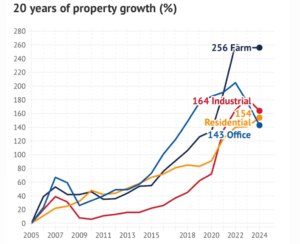Most property investors in Australia start with residential property investment. However, as you get past your first (or second) property, commercial property investment may hit your radar, and for good reason:
Commercial property offers investors attractive benefits, including much higher rental yields and diversification, but also an increased level of sophistication that calls for deeper analysis.
This article will help you understand the fundamentals of commercial property investment and if this is something you’d like to explore further.
Key Benefits Of Property Investment
Over recent decades, 95% of the Australian residential property market has moved in two directions: up, and sideways. So many investors are used to “property prices always going up”.
Commercial property is more sensitive to economic cycles.
For example, prior to the GFC of 2008, commercial office space in city centres was generally priced at a premium – especially in the “mining states” of WA and QLD. But post-GFC, the demand for tenants dried up and vacancy rates were higher. Values fell accordingly.
This goes to show that changes in economic conditions and sentiment can move the commercial property market.
That’s why it’s so important to invest somewhere where you have reasonable confidence that a sufficient pool of potential tenants will exist in order to keep your property tenanted.
Commercial property investment offers plenty of opportunity for more experienced investors.
We recommend that multiple-property owners consider commercial property as a means to generate higher yield and tap into diversification.
Apart from the special case of SMSF investment by a business owner, we wouldn’t recommend commercial property investment for first-time investors. Go residential first.
Commercial properties are a bit more like an ocean liner, as opposed to a speed boat.
They are typically more expensive to buy and harder to tenant, but once you have a solid tenant in place, they are practically a license to print money.
There are many scenarios where a developer or owner is motivated to sell a commercial property, and a shrewd investor can swoop in and buy under market value.
As we mentioned above, commercial property tends to be less liquid than residential, so if the seller wants to sell more than you want to buy, you have the upper hand.
Potential Downsides and Risks Of Commercial Property Investment
Land Tax is an annual, accumulative tax charged by all states and territories (except the Northern Territory) and is payable on any land you own (but generally excluding your Principal Place of Residence – PPOR).
The amount payable to the relevant State Revenue Office (SRO) varies slightly according to location, and is determined by the combined unimproved value of any taxable property legally owned by you.
As with CGT, negative gearing and depreciation allowances, land tax should be a consideration when drafting and implementing your ‘all weather’ property investment strategy that will outlast the averages.
With varying thresholds around when and how land tax is applied to your asset base, depending on where your investments are situated, it’s a good idea to understand the different regulations across different authorities if you plan on accumulating multiple properties.
As well as the different investment structures that can assist in minimising your tax burden as a property investor, while better protecting your asset base into the future.
For starters, different structures will come with different associated tax repercussions and some will be more advantageous than others, depending on why and how you’re investing in property.
Furthermore, how you obtain finance, along with the level of security your asset base benefits from as it evolves and provides an income into retirement, will all largely hinge on how you structure your property investment portfolio.
This is a something you should aim to get right when starting out on your investment journey, because it can be costly and tricky to untangle a messy ownership structure.







